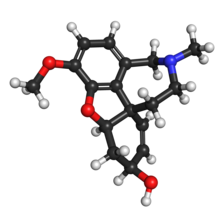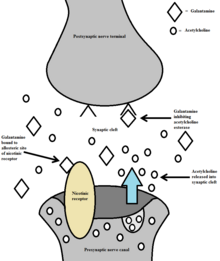Galantamine
 | |
 | |
| Clinical data | |
|---|---|
| Trade names | Razadyne, Reminyl, others |
| AHFS/Drugs.com | Monograph |
| MedlinePlus | a699058 |
| License data | |
| Pregnancy category |
|
| Routes of administration | By mouth |
| ATC code | |
| Legal status | |
| Legal status | |
| Elimination half-life | 7 hours |
| Excretion | Kidney (95%, of which 32% unchanged), fecal (5%) |
| Identifiers | |
| |
JSmol) | |
| Melting point | 126.5 °C (259.7 °F) |
| |
| |
| (verify) | |
Galantamine is an
Galantamine is primarily known for its potential to slow cognitive decline. It is used for treating early-stage Alzheimer's disease and memory impairments.[5][6][7] It works by inhibiting the breakdown of acetylcholine – a neurotransmitter involved in brain processing of memories, reasoning, and thinking.[5] It is a prescription drug taken orally.[5][7] Use of galantamine in people with dementia has only limited success, and may not produce significant results.[8] Galantamine may cause serious adverse effects, such as stomach bleeding, liver injury or chest pain.[5][7][8]
Galantamine was isolated for the first time from bulbs of Galanthus nivalis (common snowdrop) in the Soviet Union in the 1940s.[9] The active ingredient was extracted, identified, and studied, in particular in relation to acetylcholinesterase (AChE)-inhibiting properties.[10][11] The first industrial process was developed in 1959.[12][13] However, it was not until the 1990s when full-scale synthesis was upscaled and optimized.[14]
Medical uses
| Uses | |
|---|---|
| treatment of dementia caused by Alzheimer's disease[15] | |
| Who might take | |
| adults who have mild-to-moderate Alzheimer's disease as indicated by the mini–mental state examination[15] | |
| Precautions | |
| |
| Other options | |
|
Galantamine is indicated for the treatment of mild to moderate
The FDA considers galantamine to have dual status as a prescription drug and as an
Alzheimer's disease
Alzheimer's disease is characterized by the impairment of
To reduce the prevalence of negative side effects associated with galantamine, such as nausea and vomiting, a dose-escalation scheme may be used.[20] The use of a dose-escalation scheme has been well accepted in countries where galantamine is used.[20] A dose-escalation scheme for Alzheimer's treatment involves a recommended starting dosage of 4 mg galantamine tablets given twice a day (8 mg/day).[5] After a minimum of 4 weeks, the dosage may then be increased to 8 mg given twice a day (16 mg/day).[5] After a minimum of 4 weeks at 16 mg/day, the treatment may be increased to 12 mg given twice a day (24 mg/day).[5] Dosage increases are based upon the assessment of clinical benefit as well as tolerability of the previous dosage.[5] If treatment is interrupted for more than three days, the process is usually restarted, beginning at the starting dosage, and re-escalating to the current dose.[5] It has been found that a dosage between 16–24 mg/day is the optimal dosage.[21]
Available forms
The product is supplied in prescription form only in twice-a-day tablets, in once-a-day extended-release capsules, and as an oral solution.[5] Galantamine is sold over the Internet as a supplement in tablet and capsule dosage forms.[7]
Side effects
The
Galantamine has a wide spectrum of interactions with other medications and medical disorders, requiring close assessment between the physician and patient.[22]
Pharmacology
Galantamine's chemical structure contains a tertiary amine. At a neutral pH, this tertiary amine will often bond to a hydrogen, and appear mostly as an ammonium ion.[5]
Galantamine is a potent
Galantamine also works as a weak competitive and reversible cholinesterase inhibitor in all areas of the body.[5] By inhibiting acetylcholinesterase, it increases the concentration and thereby action of acetylcholine in certain parts of the brain. Galantamine's effects on nAChRs and complementary acetylcholinesterase inhibition make up a dual mechanism of action. It is hypothesized that this action might relieve some of the symptoms of Alzheimer's.

Galantamine in its pure form is a white powder. The atomic resolution 3D structure of the complex of galantamine and its target, acetylcholinesterase, was determined by X-ray crystallography in 1999 (PDB code: 1DX6; see complex).[28] There is no evidence that galantamine alters the course of the underlying dementing process.[29]
Pharmacokinetics
Absorption of galantamine is rapid and complete and shows linear pharmacokinetics. It is well absorbed with absolute oral bioavailability between 80 and 100%. It has a terminal elimination half-life of seven hours. Peak effect of inhibiting acetylcholinesterase was achieved about one hour after a single oral dose of 8 mg in some healthy volunteers.
The coadministration of food delays the rate of galantamine absorption, but does not affect the extent of absorption.[19]
Plasma protein binding of galantamine is about 18%, which is relatively low.
Metabolism
Approximately 75% of a dose of galantamine is metabolised in the liver. In vitro studies have shown that hepatic CYP2D6 and CYP3A4 are involved in galantamine metabolism. Within 24 hours of intravenous or oral administration approximately 20% of a dose of galantamine will be excreted unreacted in the urine.[19]
In humans, several metabolic pathways for galantamine exist.

For Razadyne ER, the once-a-day formulation, CYP2D6
Drug interactions
Since galantamine is metabolized by CYP2D6 and CYP3A4, inhibiting either of these
Extraction and synthesis
Since the alkaloid is isolated from botanical sources containing low amounts (0.1%) by weight, extraction yields are low.[30] Although galantamine can be produced from natural resources, it also has many industrial syntheses, such as by Janssen, Ortho-McNeil Pharmaceutical, Shire, and Takeda Pharmaceutical Company.[31]
Research
Organophosphate poisoning
The toxicity of
Research supported in part by the
Autism
Galantamine given in addition to risperidone to autistic children has been shown to improve some of the symptoms of autism such as irritability, lethargy, and social withdrawal.[34] Additionally, the cholinergic and nicotinic receptors are believed to play a role in attentional processes.[35] Some studies have noted that cholinergic and nicotinic treatments have improved attention in autistic children.[35] As such, it is hypothesized that galantamine's dual action mechanism might have a similar effect in treating autistic children and adolescents.[35]
Anesthesia
Galantamine may have some limited use in reducing the side-effects of anesthetics ketamine and diazepam. In one study, a control group of patients were given ketamine and diazepam and underwent anesthesia and surgery.[36] The experimental group was given ketamine, diazepam, and nivalin (of which the active ingredient is galantamine).[36] The degree of drowsiness and disorientation of the two groups was then assessed 5, 10, 15, 30 and 60 minutes after surgery.[36] The group that had taken nivalin were found to be more alert 5, 10, and 15 minutes after the surgery.[36]
Lucid dreaming
Though not approved by the FDA, there is interest in the recreational use of galantamine for its purported ability to induce lucid dreaming.[7]
See also
References
- ^ a b "Galantamine Use During Pregnancy". Drugs.com. February 18, 2019. Retrieved February 24, 2020.
- ^ Anvisa (March 31, 2023). "RDC Nº 784 - Listas de Substâncias Entorpecentes, Psicotrópicas, Precursoras e Outras sob Controle Especial" [Collegiate Board Resolution No. 784 - Lists of Narcotic, Psychotropic, Precursor, and Other Substances under Special Control] (in Brazilian Portuguese). Diário Oficial da União (published April 4, 2023). Archived from the original on August 3, 2023. Retrieved August 16, 2023.
- ^ "Active substance: galantamine" (PDF). List of nationally authorised medicinal products, Human Medicines Evaluation Division. European Medicines Agency. November 12, 2020.
- ^ Theodorou M. "Sustainable Production of the Natural Product Galanthamine (Defra), NF0612". NNFCC Project Factsheet. The National Non-Food Crops Centre (NNFCC). Archived from the original on March 14, 2012.
- ^ a b c d e f g h i j k l m n o p q r s "Galantamine". Drugs.com. August 8, 2023. Retrieved March 26, 2024.
- ^ PMID 16437532.
- ^ a b c d e f g h i j k l m n Kalola UK, Nguyen H (March 12, 2023). "Galantamine". StatPearls Publishing, US National Library of Medicine. Retrieved March 26, 2024.
- ^ PMID 33704781.
- ^ Proskurnina NF, Areshknina LY. J. Chim. Gen. USSR. Chem. Abst. 1947;1948;1742(1595h):1216. No title available.
- OCLC 98892008. Archived from the originalon October 23, 2018. Retrieved July 30, 2015.
- ^ Mashkovsky MD, Kruglikova-Lvova RP (1951). "On the pharmacology of the new alkaloid galantamine". Farmakologia Toxicologia. 14: 27–30.
- PMID 15137996.
- S2CID 250305879.
- ^ "Galantamine | ALZFORUM". www.alzforum.org. Retrieved November 17, 2019.
- ^ a b c d e f g h i j k l m Informulary (April 2014). "Drug Facts Box: Razadyne (galantamine)" (PDF). Consumer Reports. Archived from the original (PDF) on March 4, 2016. Retrieved November 5, 2015.
- ^ "Galantamine hydrobromide (trademark)" (PDF). US Food and Drug Administration. 2004. Retrieved December 17, 2017.
- PMID 24043661.
- ^ "DietarySupplements: New Dietary Ingredient Notifications and Related Issues: Guidance for Industry". Center for Food Safety and Applied Nutrition. Food and Drug Administration, U.S. Department of Health and Human Services. August 2016.
- ^ S2CID 36855768.
- ^ S2CID 1172847.
- PMID 24591834.
- ^ a b c "Galantamine". Mayo Clinic. 2024. Retrieved March 26, 2024.
- PMID 16437532.
- ^ S2CID 6795456.
- PMID 11172080.
- PMID 32205338.
- PMID 29669164.
- S2CID 573270.
- ^ "Ortho-McNeil Neurologics, "Razadyne ER US Product Insert", May 2006" (PDF). Archived from the original (PDF) on December 22, 2009. Retrieved December 21, 2009.
- PMID 28337117.
- PMID 28031923.
- ^ PMID 16914529.
- ^ Albuquerque, Edson X, Adler, Michael, Pereira, Edna F.R. (January 22, 2009). "United States Patent Application 20090023706". US Patent and Trademark Office. Retrieved May 27, 2016.
- S2CID 206491732.
- ^ PMID 17069550.
- ^ PMID 3631427.
External links
- "Galantamine". Drug Information Portal. U.S. National Library of Medicine.
